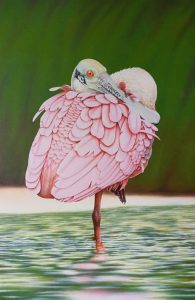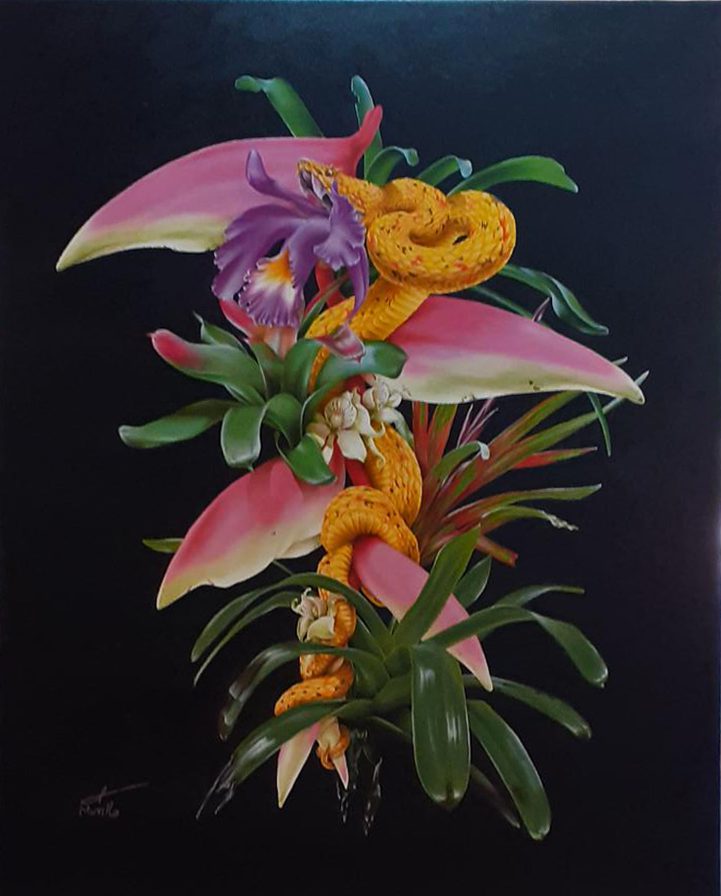Welcome once more to our Artist Spotlight series called “Making a Scene.” In this issue, we feature the selected works of Costa Rican artist Allan Murillo, who was profiled in the January 2021 Howler article entitled Painting What Comes Naturally. Allan is here now to share personal insights into the inspiration and creative process behind some of his selected paintings.

Tiribí
Living in San José is an experience that exposes a lot of contrast: One can observe in an almost omnipresent way the natural beauty of the Central Valley. At the same time, its decay is evident — all for the sake of development. This decay of the ecosystems finds a faithful representative in the rivers that drain the Greater Metropolitan Area (GTA). The Tiribí, María Aguilar and Torres are some of the rivers most affected by human activities.
This piece was created as an allegory to the few natural spaces that we can still access, here in the GTA, that are preserved in their natural state. The Tiribí River is, for me, special. Close to the source of the waters of this river, the original richness of the area is maintained in very good condition. This contrasts with the image of this stream of water being subjected to contamination.
In this part of the river, it is possible to observe quetzals in a place that is very close to the center of the capital. It is remarkable that this type of beauty survives in such a place, considering that only a few kilometers downstream it is transformed into rubbish due to dumping. This painting is to remind us that there are reasons to conserve what still remains.
Tranquilidad
This piece was conceived in relation to the coincidental state of mind between the observer and the observed, during a random moment.
One day I was quietly strolling and enjoying a very pleasant feeling of fulfillment. Suddenly I had the joy of seeing this very beautiful pink spoonbill perched elegantly in some shallow water, on only one of its legs. You could perceive its tranquility. I felt as if there was a state of peace shared between the animal and myself in that small lapse of time. In honor of that instant of connection, I decided to paint the same bird that gave me that special moment.
Sometimes we witness moments that inspire; that was the case with “Tranquilidad.”
Madreflora
It’s strange how from time to time, a project stops being what was intended and ends up being something much better. Time can provide a level of maturation of the concept — from the point where it is conceived to when it is time to take up the brushes.
The prospect of a very interesting project came about when I was asked to do a mural, with references to the flora and fauna of Costa Rica. But at the same time, I wanted the design to be unconventional. I was interested in having more creativity in terms of exposure of the elements and the composition of the final painting. Although the final artwork was approved a few days later, I was informed there was a budget issue and the project was canceled.
However, “Madreflora” refused not to be created, even if this meant going a distance from the original idea. I took the motivation I already had, modified some concepts and it magically appeared in front of me: an ode to biodiversity, with a good amount of personality of its own.
 Antropoceno
Antropoceno
My inspiration for this painting involved some serious retroflection. Faced with the evidence that animals have less habitat nowadays, I also considered that they have begun to absorb some of our human behaviors and characteristics.
Earth’s history is characterized by four eons. From oldest to youngest, these are the Hadeon, Archean, Proterozoic, and Phanerozoic eras. There is now what’s called an “Anthropocene era.”
The “Anthropocene” epoch — coming from “anthropo” for “man” and “cene” for “new” — is an unofficial unit of geologic time used to describe the most recent period in the earth’s history. It’s when human activity started to have a significant impact on the planet’s climate and ecosystems, causing mass extinctions of plant and animal species, polluted oceans and altered atmosphere, among other lasting outcomes.







